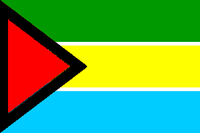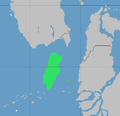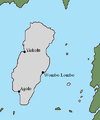Shango
| Shango | |||
|---|---|---|---|
|
| |||
| Motto:Irestrovi Ishogi Vanestruvi Peace Through Unity | |||
| Anthem:Shango Eleveseri Beautiful Shango | |||
| Location | Shango Political Map | ||
| Area | 394,500 km2 | ||
|
2.93% | ||
| Demographics | |||
| Population | 18,310,000 (2014 EST) | ||
| Density | 47/km2 | ||
| Government | |||
| Capital | Wombo Lombo | ||
| Type | Republic | ||
| President | Akyola Bikongi | ||
| Legislature | General Assembly | ||
| Official Languages | Unonian, English, Batongan | ||
| Economy | |||
| Currency | Shango Assay (S) (SHA) | ||
| Economic Structure | Capitalism | ||
| GDP (2014) | $522 billion | ||
|
$26,509 | ||
| Unemployment | 9.8% | ||
| Gini | 24.1 | ||
| Development | |||
| Life expectancy | 67.1 years | ||
| Improved water access | 88% | ||
| Literacy | 88.9% | ||
| Enrollment | 92.1% | ||
|
N/A | ||
|
N/A | ||
|
N/A | ||
| PDAS rating | N/A | ||
| Standards | |||
| Measures | Metric | ||
| Date format | day-month-year | ||
| Traffic | Right-hand | ||
| Codes | |||
| ISO code | SNG | ||
| TLD | .sng | ||
| Calling code | +31 | ||
The Republic of Shango is a democratic, multi-species nation located in The East Pacific. It is an archipelago consisting of seven islands (one main and six periphery) situated off the distant coast of the continent of Yasteria. To the north is the nation of Isklevyu and Algaisia, with Fortuna and Packilvania to the east, and New Leganes to the southwest. Shango is a biodiversity hotspot, with over 80% of its wildlife exclusive to the nation.
Geography
At 738,550 km2, Shango is an average-sized nation in The East Pacific and among the largest island nations in Urth. The prehistoric breakup of the island from Yasteria provided the opportunity for diverse animals, and fauna exclusive to Shango, due in part to the several ecosystems that make up the main island. This is a result of the mountainous ridge consisting of older mountains running down the center of the island. Much of the westerrn portion of the nation consists of tropical rain forests and sandy beaches along the coast of the nation. East of the ridge is dominated by plains, dubbed The Central Highlands, which are dotted with deciduous forests and, in the extreme south, spiny forests with arid lands. Rice fields are found in the northeastern portion of the nation, as lowlands provide hospitable conditions for growing rice.
Smaller islands are typically consist of rain forests, though some smaller coral atolls exist and have been used for mining phosphorous.
Industry
The major industries of Shango include fishing, mining, farming, oil drilling, and tourism. Fishing has long been a staple of Shango, which for centuries has fished from the expansive waters of the Gulf of St. Aiya. Mining typically takes place along the central ridge in the island, where iron ore and copper is aplenty. Farming is common in The Central Highlands and the lowlands to the north of the island. Oil, which helped provide a boon for the Shango economy in the 1970's, is drilled on the western portion of the island and offshore. The area boasts strong oil reserves that is estimated to last for centuries. Tourism, due in part to the stability of Shango and its tropical location, remains a strong industry to the island nation.
Demographics
The island consists of mostly Lemurian individuals who have inhabited its lands for thousands of years. The Lemurian people are sophisticated beings who have adapted a use of a prehensile tail which they use during daily tasks. These Lemurs prefer warmer climates. Other small groups of individuals, including humans and a small population of vulpine individuals live in the nation, but their numbers are dwarfed by the Lemurian people.
Lemurian cities have a lot of the ecosystem still intact; that is, Lemurian people plan their cities around the surviving ecosystem. Their buildings - typically white-walled with large windows and plenty of hanging polls to both climb and cling to - are unique and are often unexpected for the casual tourist. Roofs typically allow for vegetation in an attempt to blend in the ecosystem with their modern architecture.
Religion
Shango is mostly a Christian nation, with some 73% claiming devotion. Of those, the majority (roughly 80%) are Vayan Catholic, no doubt a direct result of the ministering efforts of evangelicals from Vekaiyu some four hundred years prior. The next largest group is an agglomeration of various tribal beliefs that spawned from ancient shamanism practiced on the island for thousands of years.
History
Archelogical digs in and around the main island suggest a sophisticated tribal society existed as early as 1500 B.C. This group of Lemurian peoples would slowly expand to other smaller islands around the main island, but seemed to never venture to coastal lands. In 1552, missionaries from Vekaiyu attempted to convert the Lemurian peoples to Vayan Catholicism, which was quickly accepted by two major chieftains, both of which believed the missionaries to be gods. With the success of the missionaries, Vekaiyu set to work on colonizing the nation, but abandoned its efforts twenty years later in 1598 as the nation underwent several partitions. This did not dissuade the already-present population of Vekaiyuns who set to work aiding the native Shangoese population with building roads, churches, and various other modern amenities.
Over time, the numbers of the Vekaiyun population dwindled, but their technology was not forgotten. Shangoese individuals constructed massive ships in an attempt to trade and interact with nations around them. This again caught the interest of Vekaiyun traders, who again attempted to colonize the nation in 1826 and establish a major port town - Yiskolu - which also served as the nation's first capitol. The Vekaiyuns, who had hoped to use the island as a major trading and naval hub, were unable to establish control over the entire island, due in part to the Vekaiyun government providing little help and instead investing in expansion more closer to home. The colony was finally lost in 1898 when a rebellion forced them out of power. A king, Agolo I, was declared, and both he and his two successors - Agolo II and Agolo III - further modernized the nation.
In 1966 after the death of Agolo III, the nation opted for a democratic government. The capitol was moved to Wombo Lombo, a large city built on the edge of a large rain forest that backed to the coast, and established a constitution. The nation remained in obscurity until 1977 when the nation discovered oil in The Central Highlands. This caused a boon in trade and provided the nation a boost in its economy, and motivated its people to devote time and effort into education. The 1990's shifted focus to military spending after fears of a Vekaiyun invasion led by Max Venavle dominated the periodicals.




